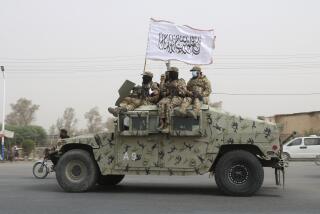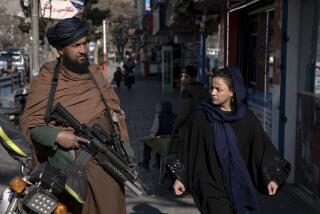Rule of Gun on the Rise After Ouster of the Taliban
ISHPONI BABA, Afghanistan — Ayub slowed as he approached the random checkpoint, manned, as it were, by a boy with an AK-47 slung across his chest. The instant the young guard lowered his hands from his gun, convinced that the car was stopping, Ayub stomped on the accelerator.
The feint earned the station wagon a precious second or two. The guard whirled as the car sped past, unslinging his weapon. But he was perhaps 100 yards back and fading quickly into the distance by the time he had nestled the rifle into his shoulder and taken aim. He didn’t fire.
“Ah, ha, ha!” called Omar Nassih, a translator in the front passenger seat, slapping Ayub on the back. “He probably wouldn’t have shot anyway. He might get in trouble.”
Such incidents are hardly unusual now in many parts of Afghanistan. The day before, two shots rang out as the same car drove through the Shomali plain, three hours to the northwest. The day after, just up the road from here, it was three shots, with an armed guard in the car answering with a burst of his own.
As Afghanistan’s interim government tries desperately to move this demolished country into the category of somewhat functional Third World nation, one problem looms, perhaps above the myriad others: rampant lawlessness.
The outside world is trying to help bring some measure of stability to the country. The United States, or “the Big Boss,” as many here call it, continues to bomb suspected Al Qaeda and Taliban hide-outs almost nightly in the south and east of the country in an attempt to root out terrorists. International peacekeepers are beginning to patrol the capital, Kabul. Aid agencies are flying and trucking humanitarian supplies as quickly as possible into a country where the United Nations operates on its highest threat level.
Despite such efforts, this is a land so perilous it can boggle the mind of anyone who has lived in peace. Afghans say that, since the fall of the Taliban, murder, bribery, kidnapping, extortion--crimes committed primarily by soldiers working for one warlord or another, most believe--have only grown worse.
Leaders here and abroad are beginning to ask the question: How can a nation be rebuilt when moving about it sometimes means courting death?
“Security is the most important thing in any crisis in any nation,” said one Western diplomat in Kabul. “If a country is secure, people will stay, refugees will return, food will come, things will improve. More than drought or famine or anything else, insecurity is the most destabilizing force.”
Here in Ishponi Baba, insecurity is almost all there is.
Forty miles east of Kabul, the village--if 15 men with a lot of weapons, a one-room hut and a bag of onions can be called a village--is perched 50 feet above one of the most dangerous roads in Afghanistan.
The Kabul-Jalalabad road has been a home for mayhem since it was only a donkey trail between the capital and the eastern city. For perhaps hundreds of years, several different tribes have claimed various parts of the route and fought over it almost constantly.
The geography of the area also makes the route a bandit’s paradise. The road, mostly dirt and gravel, is so rutted that vehicles can often travel no more than 5 or 10 mph. Heading east from Kabul, the sheer Mahipar mountains on the left are a stone barrier to escape and a hide-out for brigands. On the right is another nearly vertical drop, down to the Kabul and then Panjshir rivers.
“Somebody who loves his life cannot live here,” said Gul Agha, one of the soldiers here.
The same is increasingly true for those who simply want to pass through. Four international journalists were stoned and shot to death in November just up the road, near Sarobi. A taxi driver, who was last seen picking up a group of Northern Alliance soldiers in Kabul, was found dead recently with four bullet wounds in his chest. His car is missing.
Traveling British aid workers were stopped last month, robbed and relieved of their vehicle. They were the only recent robbery victims, as far as anyone can recall, who were not killed.
Here, as in many parts of this mostly rural country, robberies that don’t lead to murder seem increasingly rare, with highwaymen apparently finding it safer to eliminate witnesses then and there.
Since the fall of the Taliban, everyone is convinced that the murder rate has risen, although no one has the slightest idea of any statistics. Though brutal and repressive, the Taliban did create a society of very little violent crime.
What is certain is that early optimism in the new government’s ability to keep order has waned considerably in recent weeks.
Adding to the growing sense of fear is the unpredictability of the violence; one day a road is clear and safe, the next it’s a gantlet of unofficial checkpoints, where the guards may want $100 for passage, or wheat bound for refugees, or your truck and in turn your life.
“Maybe you will go to Kabul safely,” said Rahmatullah, a tall, shy soldier stationed at Mahipar Dam, a few miles up the canyon. “Maybe your pockets will be robbed. Maybe you will be killed.”
The men here in Ishponi Baba are all ethnic Pushtuns, as were the vast majority of the Taliban. They say they weren’t Taliban, though everyone else up and down the road says they were. Those who say the men of Ishponi Baba were Taliban are themselves ethnic Pushtun soldiers, and likewise are identified as former Taliban by virtually everyone at every other post.
Regardless of former allegiances, almost every man living or working along this road is a soldier, and in the service of a warlord, not Afghanistan.
Those here say they have not been paid for months. They have water, but only the onions to eat. Most can’t read, and those who can have no books. They have no radio. They have nothing to do but climb around in the rocks with their Kalashnikovs and rocket-propelled grenade launchers and watch the road below.
“Our area is safe, but don’t go any further,” said the commander, Ghuncha Gul. “Back that way where you came from is also maybe not safe.”
This is a refrain heard all along the route. The soldiers at the previous outpost said the same thing, as did the ones farther up the road.
They may all be telling an odd truth. It is commonly believed that bandits, whoever they are, strike travelers in another group’s territory, then rush back to their own. The safest place in this canyon may be at the home base of a pirate.
When asked if the men at Ishponi Baba and other outposts on the road were bandits as well as soldiers, Atiqullah, a guard at the checkpoint at the western entrance to the canyon, demurred. “Allah knows,” he said.
Without the national army that interim Prime Minister Hamid Karzai hopes to build, there is no way to close the pass and clear the armed men out. Doing so would hardly address the problem, anyway, because this route is not unique.
Although a handful of regions is considered relatively safe--mostly in the northeast and southwest--many more are deemed the opposite by international relief and other agencies.
The United Nations is operating in Afghanistan under rules known as “Phase 5,” meaning no workers are allowed to travel alone, or at night. They cannot go anywhere without a two-way radio, or anywhere out of radio range. In Kabul, U.N. workers must be in their homes by 9 p.m., an hour before the official government curfew. In Kandahar, the former Taliban stronghold, workers have been ordered to stay in their homes and not go to work for more than two weeks now.
The British-led International Security Assistance Force has begun patrolling in and around Kabul during the past few days, with 1,500 international troops on the ground and 3,000 more expected to arrive over the next several weeks.
During negotiations in December near Bonn over the peacekeeping mission, Interior Minister Younis Qanooni fought effectively to limit the number of international soldiers and to restrict their operations to the capital.
After several kidnappings and killings in Kabul in recent days, apparently for money, and amid a growing sense of instability in a city that just a week ago appeared to be the one relatively stable urban center in the country, Karzai and Qanooni have begun to suggest publicly that they may ask for more troops--both for Kabul and other cities.
The kind of peacekeeping Afghanistan needs, however, may be enormous.
“If you really want to stabilize Afghanistan, you’re looking at estimates ranging from 50,000 to 200,000 troops,” said a U.S. diplomat in Kabul.
At Ishponi Baba, Ghuncha Gul, the commander, had no hopeful words for those expecting change in Afghanistan.
He adjusted the wool hat on his head, pulled at his beard and pointed down at the Kabul-Jalalabad road.
“There are more problems now than before,” he told his visitors. “Robberies happen all the time, and if they can kill the people, they do that. We don’t care about our lives here. People who care about their lives should go. The sun is going down.”
More to Read
Sign up for Essential California
The most important California stories and recommendations in your inbox every morning.
You may occasionally receive promotional content from the Los Angeles Times.










